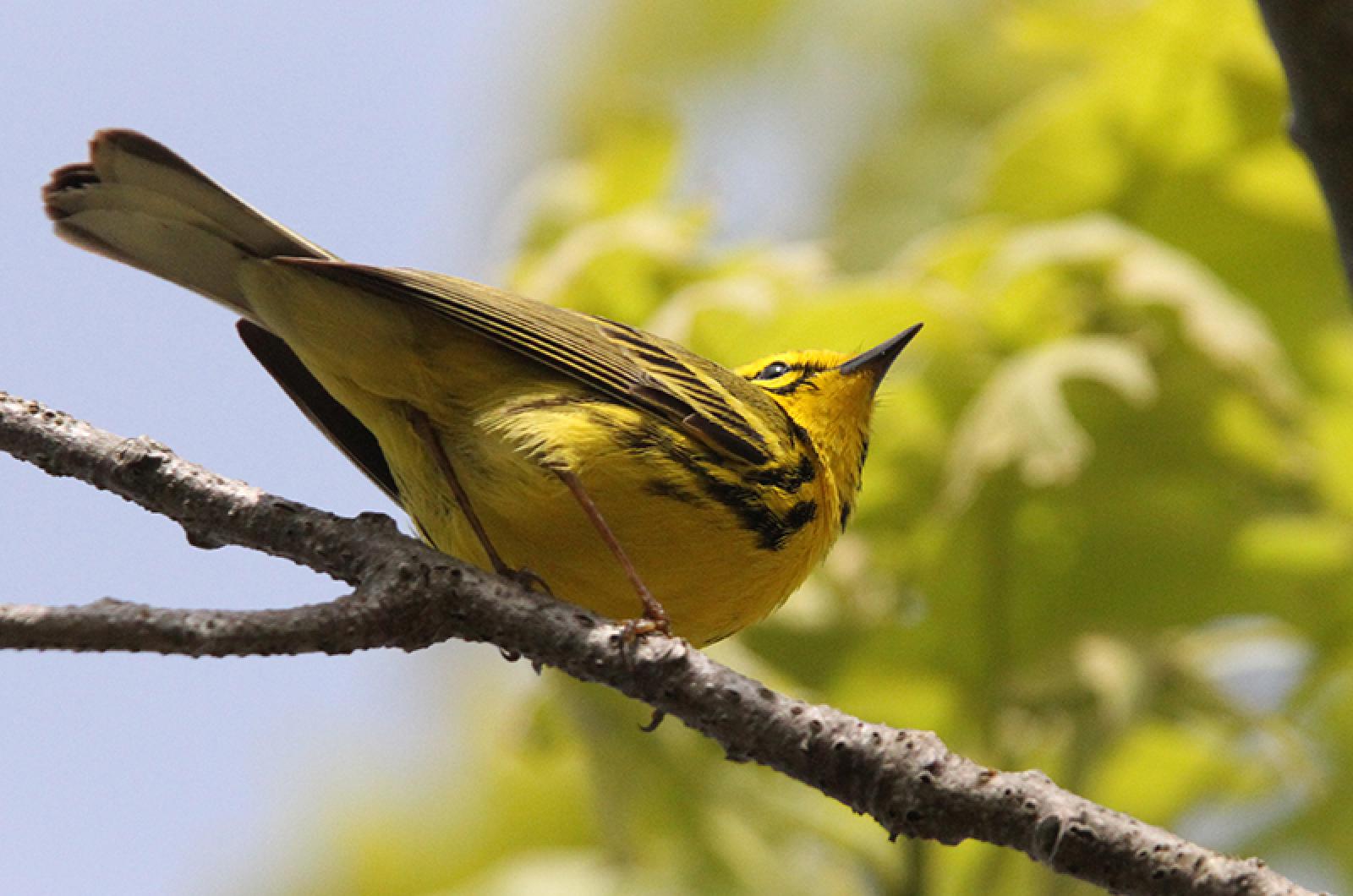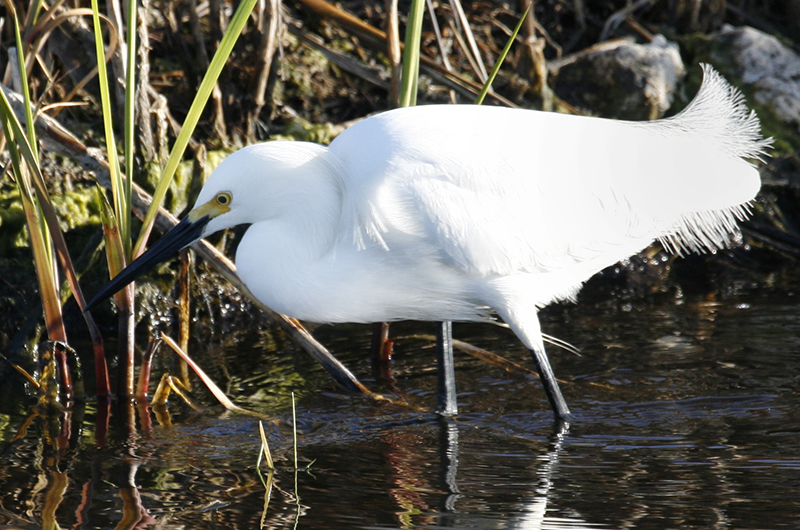Thirty or more years ago snowy egrets were more abundant than great egrets, but things change in nature over time. Great egrets have been here for a while and although not super abundant are more common than snowies. We have the first reports of snowies with Lisa Maxfield finding one at Brush Pond on April 9 and Olsen Houghton finding one the next day at the entrance to Lake Tashmoo. Great egrets were spotted by Mark and Sue Shea at Katama on April 6, and by Gus and Deb Ben David at Farm Pond on April 12.
Elsewhere on the waterbird front, Albert Fischer spotted a Wilson’s snipe at Squibnocket on April 7 and that same day Anne Whiting spotted two greater yellowlegs at Farm Neck.
Songbirds are migrating too. Luanne Johnson spotted our first field sparrow of the season at the State Forest Headquarters on April 9, while Bob Shriber spotted one at the Farm Institute on April 12. That same day, Bob Shriber spotted an eastern towhee at Pilot’s Landing in Aquinnah, and the troika of Luanne Johnson, Margaret Curtin and Nancy Weaver found two towhees near Lambert’s Cove Road. Gus Ben David spotted a purple finch — a species that formerly nested on the Island — in his yard on April 12. And Bridget Dunnigan and Sea Williams heard a prairie warbler singing at the eastern end of the State Forest on April 12.
Bird Sightings
The most studied sighting this week is Luanne Johnson’s first year male Barrow’s goldeneye that was frequently diving in the small and very shallow pond next to the state forest headquarters, which for the first 18 years of this century held virtually no water. This fresh-water location is unusual; I do not recall any other goldeneye sighting there. A number of us (Margaret Curtin, Bob Shriber, Nancy Waver, Lanny McDowell and myself) went there to see it thinking it was a Barrow’s goldeneye. Or was it a common goldeneye? Field marks like shape of the head, its forehead, and the size of its bill were all discussed by texting each other, as we were not there together. Jeremiah Trimble was consulted and the verdict came back that it was indeed a Barrow’s! None of us realized how similar first year males of these two species are. Our difficulties identifying this duck suggests that we see only adults and not first year males of either species. Why is that?
Gannets continue their migration along the South Shore of the Island, although some of the time they are along the horizon. Alan Karney and Albert Fischer each report they are migrating past by the thousands. They are less common in Vineyard and Nantucket Sounds, but John Nelson saw a small flock of them diving into the water off East Chop on April 7.
On April 10, Lanny McDowell also spotted four horned grebes that were in their breeding plumage, “yellow horns and all.” We usually see the more nondescript winter plumage.
Migrating kestrels were observed by Hans Goeckel at Katama on April 11 and by Albert Fischer at Squibnocket on April 7. Mr. Goeckel also spotted a northern harrier; others to report harriers include Mariah Ben David at Quansoo Farm on April 11 and Martha Moore near Middle Point Cove on Tisbury Great Pond that same day.
Holly Mercier still has bluebirds coming to her bird feeders, as she has had all winter. So does Sandra Talanian. Their blue backs are quite flashy and fun to see anywhere. Isaiah Freedman spotted one along South Road in Chilmark near the southern end of Fulling Mill Brook on April 10.
Laurie Meyst had both cedar waxwings and pine warblers at her feeders on April 8. The former species was not seen as frequently as usual this past winter. The later species has suddenly become more abundant this week. Luanne Johnson spotted eight of them at various locations around Lambert’s Cove Road, Matt Pelikan heard pine warblers singing on Chappaquiddick on April 8, and I have heard them singing from several of their nesting sites in pine woodlands.
From Chappaquiddick on April 8, Matt Pelikan reports an eastern phoebe, a small group of tree swallows, and two adult lesser black-backed gulls. We have had numerous reports of two adult lessers these past few weeks. How many different ones have we seen, or are they the same two birds moving around Edgartown and Oak Bluffs?
Mariah Ben David reports the following highlights of her birding on April 6: a gadwall and two wood ducks at Tiasquam Valley, a dozen harlequins and a handful of ring-necked ducks at Squibnocket, and three red-throated loons at Lucy Vincent Beach.
There are two pairs of osprey nesting at Felix Neck. The second pole, the historically empty one north of the entrance road, hosted a pair last year that built a nest but did not lay eggs. This year they are back and will likely be laying eggs. I asked Gus Ben David about it and he reports that the second pole was put up about 40 years ago. Many times a pair would attempt to set up on the second pole (only 440 feet away from the established pair) but the resident male would drive them away. Territoriality varies greatly, but is generally lower when populations are high as they are now (about 100 breeding pairs). This is the shortest distance between any two pairs on the Island.
The final sighting for this column is that American goldfinches are molting from their dull greenish/gray winter plumage to their bright yellow and black breeding plumage. Gwen Nichols photographed this welcome sight at her feeders. Happy spring.
Watching birds helps relieve the isolation of social distancing! Stay healthy and report your sightings to birds@mvgazette.com.
Robert Culbert is an ecological consultant with Nature Watch LLC living in Vineyard Haven.










Comments
Comment policy »